Integrated Pest Management for Cannabis Cultivation Monitoring, Identifying, Preventing, and Controlling Pests with HVAC Solutions
Learn about the four major steps of integrated pest management (IPM) programs: setting action thresholds; monitoring and identification, prevention, and control; the various control methodologies; and how climate control systems both enable indoor cannabis cultivation and can manage pests like mold and mildew.
Learn about the four major steps of integrated pest management (IPM) programs: setting action thresholds; monitoring and identification, prevention, and control; the various control methodologies; and how climate control systems both enable indoor cannabis cultivation and can manage pests like mold and mildew.
Monitoring, prevention, and control of pests in cannabis cultivation require an integrated pest management (IPM) plan. Scouting for pests can be performed by humans or software. With a combination of visual inspection and computer vision, the productivity of plants can be optimized, and the application of pesticides can be minimized. In addition, high-performance heating, ventilation, cooling, and dehumidification (HVACD) systems can maintain target environmental conditions that can prevent the growth of pest populations. You can use mechanisms such as filtration, light treatments, and photocatalytic oxidation to control outbreaks. No matter how you grow, IPM principles can benefit your crop, and HVACD solutions can be a part of your IPM strategy.
Tactics for Controlling Pests and Microbes
Crop loss from pests is painful, yet avoidable. With proper planning, you can keep bugs out from the get-go and stop outbreaks in their tracks. Many pests affect cannabis production facilities and are necessary to manage in indoor, greenhouse, or outdoor environments. They fall into three major categories:
- Insects and arachnids like thrips, whiteflies, spider mites, and aphids
- Mollusks like snails and slugs
- Microbial organisms like bacteria, fungi, nematodes, and viruses
Growers can use various strategies to avoid and control pests, including cultural, physical, biological, and chemical tactics. Integrated pest managementprevents or suppresses damaging insect pests by applying multiple control tactics in a comprehensive, coordinated, and integrated manner (1).
Integrated pest management (IPM) plans have four major components:
- Setting action thresholds
- Monitoring and identification
- Prevention
- Control
Action Thresholds
The “culture of clean” starts with operational activities that establish action thresholds and procedures to follow. Be thoughtful about your plant process flow. Track against thresholds and establish quarantining processes for infected plants. Prevent pest outbreaks with quality training and standardized procedures that mitigate risks with management plans. Action thresholds are points at which pest populations or environmental conditions indicate that pest control action must be taken. For example, you decide whether spotting one or five spider mites means an action is required. In your standard operating procedures, define the level at which pests become an economic threat so your team can guide their future pest control decisions (2).
Monitoring and Identification
Establish which organisms require control. Monitoring prevents the overuse of pesticides, and correct identification avoids you using the wrong kind of pesticide. Pest scouting approaches vary by level of sophistication. For example, human staff can visually inspect plants, or growers can deploy digital solutions to photograph plants and use computer vision to detect and report issues.
Every grow operation should always employ a level of visual inspection by human staff to cross-check against reports from digital systems. Inspect incoming plants, use indicator plants, and use sticky cards to track and review scouting information periodically (3).
Competitive grows utilize a combination of visual inspection and computer vision to optimize the productivity of plants and minimize the application of pesticides. Computer vision incorporates artificial intelligence and robotics with high-resolution photography to be everywhere all at once. There are three main benefits to using computer vision solutions for indoor agriculture:
- Plant health – AI helps determine the health status of any plant by comparing large data sets of images against photographs of your plants day after day to detect diseases and track photosynthetic health.
- System monitoring – Beyond direct sensor readings, large data sets of factors like CO2, fluid flow, fluid pressure, temperature, and others, can be used to flag faults in your systems.
- System optimization – Large data sets describing the life experience of the plant using grow room conditions such as light levels, temperatures, and humidity. Growers can use this information to improve the performance of the system for any cultivar.
Pest Control Methodologies
There are four primary prevention and control methodologies. The IPM triangle progresses from prevention to intervention, starting with cultural control, creating an environment where plants thrive, and bad bugs don’t (Figure 1).
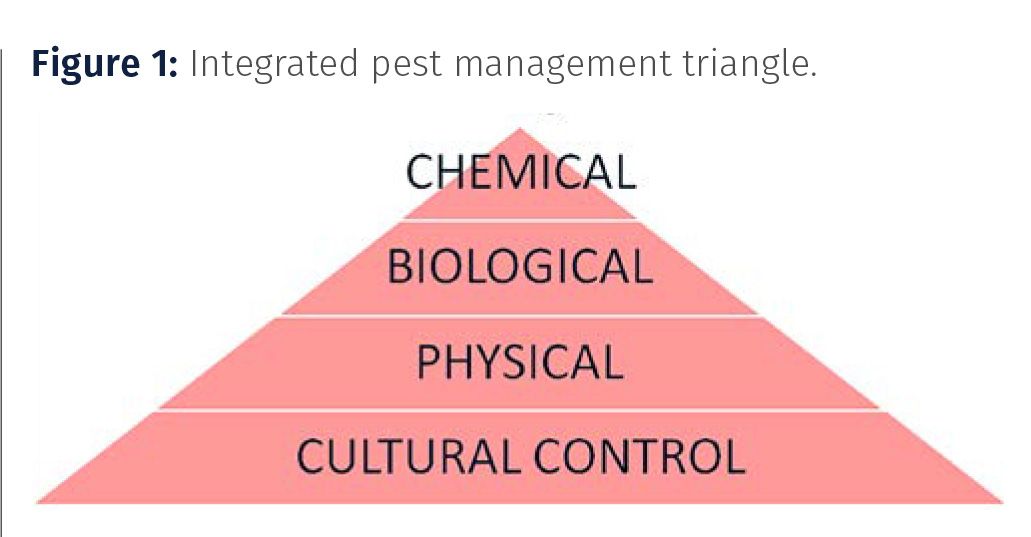
First, cultural strategies can be fruitful, cost-effective, and present no harm to people or the environment. Cultural control is environmental control and is the foundation of any comprehensive IPM plan. According to Jesse Porter of Inspire Transpiration Solutions, it is the oldest IPM method but was largely abandoned with the advent of chemical pesticides. However, with consumer demand for greater availability of reliable, clean, pesticide-free cannabis, there has been renewed interest in cultural control.
Second, physical control methods include traps, barriers, processes performed by HVAC systems such as filtration and ultraviolet (UV) light treatments, and the physical removal of pests by growers.
Third, biological control introduces beneficial insects and good microbes to work on your behalf. Trap plants can draw pests out of your crops or be testing sites for beneficial biological controls, banker plants rear beneficial parasitic insects, and habitat plants feed the natural enemies you deploy against your pests. Guardian plants attract pests, feed beneficials, and provide interactions between your pests and the biological controls you introduce in your grow rooms (4).
Finally, as a last stage of control, chemical methods deploy materials that are toxic to insects but not your plants (5).
HVAC Systems for Pest Management
Within each cultivation space, environmental conditions can slow or accelerate the spread of pathogens. The precision in which you can control temperature, humidity, and airflow dictates the impact you can have on microbial sporulation, pest mating cycles, and the efficacy of your IPM applications. For example, sulfur is more effective in high-humidity environments and will become phytotoxic in high-temperature conditions. A second example: cooler temperature setpoints stimulate diapause in spider mite populations to slow feeding and reduce plant damage.
Indoor cannabis grow rooms are typically small spaces with large-capacity HVACD equipment. High-performance HVAC systems can serve to implement both preventive and control strategies of your IPM plan. Proper selection of the HVACD system components is critical for mitigating pests as HVACD equipment purpose-built for cultivation and drying can protect plants by maintaining optimal environmental conditions.
Integrated machines with controls that track environmental conditions to manage cooling, dehumidification, and heating demands simultaneously are critical to maintain conditions during the challenging transition period between lights on and lights off. Powdery mildew and botrytis—root rot—have plagued cannabis cultivators for years. One major factor for these outbreaks is inconsistent maintenance of target environmental setpoints during the lights off period. As the 12-hour flowering lights on period ends, your cannabis continues to transpire for 45–90 minutes at a very high rate.
Air temperature directly affects relative humidity, and when lights turn off, temperatures swing low. Without appropriate heat provided by HVACD equipment during lights off, spikes in temperature occur, and pest vectors are created in your grow rooms. Without quality controls, sensors, and HVACD components that can modulate to handle dynamic conditions, these plant stresses will occur daily. The result is a loss in plant vitality, yield, and quality. Closely monitoring and controlling conditions of your supply air to zones ensures your systems leverage the capacity of HVACD equipment properly to support the IPM goals (Figure 2).
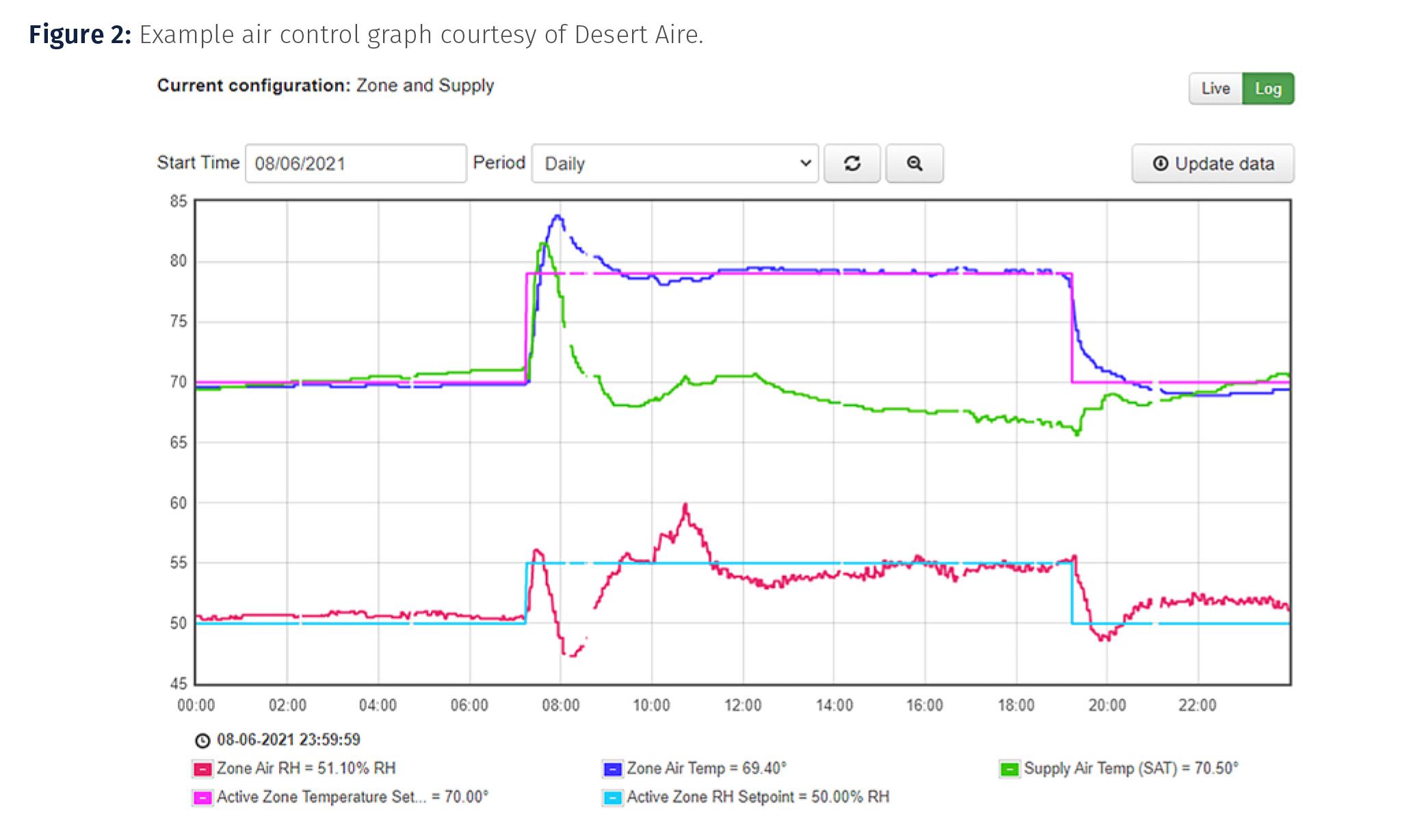
Prevent your HVACD system from becoming a source of pests by appropriately designing and maintaining your equipment. “With the amount of dehumidification needed for cannabis cultivation, anaerobic water can be a vector for water molds. To prevent the spread of fungal pathogens detrimental to cannabis production, evaluate drain pans, ducting, and HVACD system condensate lines regularly,” said Porter.
When choosing control strategies for your IPM plan, consider effective, less risky pest controls first, for example, mechanical controls such as trapping or weeding or highly targeted chemicals, such as pheromones, to disrupt pest mating. If staff continue to monitor and identify pests and action thresholds indicate that less risky controls are not working, additional pest control methods can be employed. The best mechanisms recommended by RII’s Technical Advisory Council to control pest outbreaks are filtration, UV light treatments, and photocatalytic oxidation. Consider using multistage approaches for your IPM plan.
Filtration
Filters are a form of physical pest management that can prevent pests and pathogens from entering air streams or recirculating into your grow rooms. Filters are rated using ANSI/ASHRAE Standard 52.2-2017, a testing method that assigns a number from 1 to 16. Cannabis cultivators are encouraged to use MERV 13 filters as the first stage of physical pest prevention and control.
Light Treatments for Pest Management
UV light can be used as an IPM strategy in three areas of mechanical systems serving indoor cannabis facilities: at the cooling coils, within the air ducts, or within the environment using upper-air UVC fixtures (Figure 3).
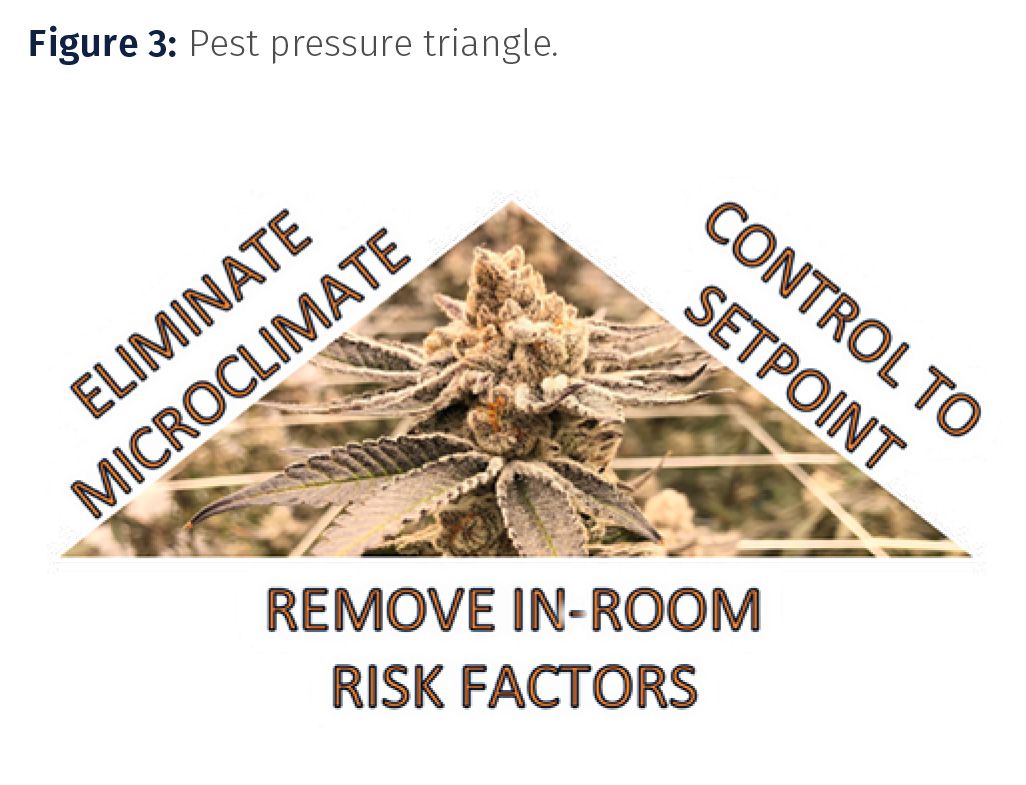
Cooling coil surface treatment may have more limited impacts when compared to the other methods of UV treatment in the growing environment and focuses on the wetted coils within the HVAC equipment. “Since the air is moving quickly within the cabinet and the effectiveness of UV lighting is dependent on both time and intensity, UV directed at the cooling coils is an alternative to mechanical and chemical cleaning of the coils,” said Craig Burg of Desert Aire. “In indoor plant environments, the wetted coils are almost always cold and there is a continuous flow of condensate. This limits the growth of microbes and biological contaminants on coils.” Evaluate polymeric materials such as plastics inside air-handling equipment and ducts for compatibility as these may degrade when exposed to UV light.
In-duct UV disinfection cleans your air and results in greater disinfection rates of airborne microorganisms. High-intensity UV tubes are typically placed lengthwise down the duct to allow for more exposure time as the air passes by the lights.
Upper-air UVC fixtures work similarly to in-duct solutions, but are mounted in the room, typically high on the walls. Air moves relatively slowly across the fixtures, increasing the length of exposure for microorganisms.
For all three methods, it is vital to take precautions to manage human exposure to direct and reflected UV light. “Implement proper shielding to ensure both personnel and plants are not exposed to UV radiation, and consider installation and servicing as well as operation,” noted Burg. Exposure to UV has significant adverse health effects if humans are exposed.
MERV 13 grabs anything larger than 1 µM in diameter, but photocatalytic oxidation processes can destroy smaller pests. Another application of UV light treatments, photocatalytic oxidation is a special kind of UV treatment that combines UVC irradiation with a titanium dioxide catalyst that reacts and shreds malignant contaminants into water, carbon dioxide, and harmless by-products.
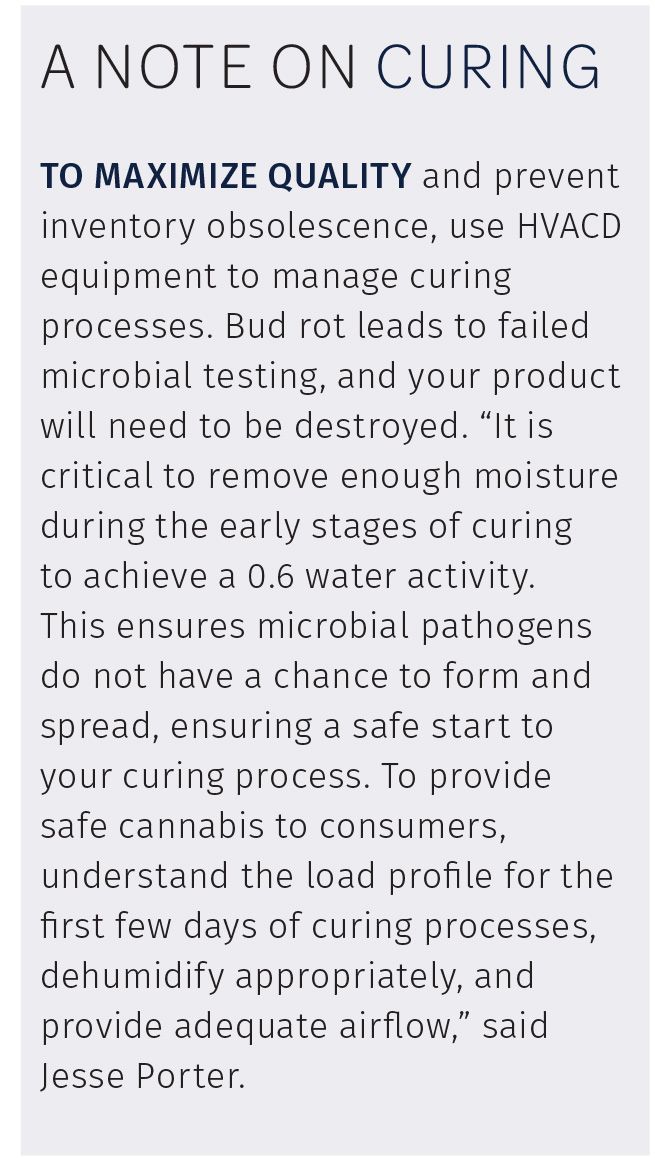
Best IPM Practices
Keep an eye out for additional tips for HVAC controls in Resource Innovation Institute’s next peer-reviewed Best Practices Guide (6) on Automation & Controls for Cannabis Producers coming this summer. As a non-profit organization, RII brings together producers, utilities, designers, builders, and technology providers to help cultivators successfully adopt efficient techniques and ensure resilient harvests into the future. Some tips to consider include:
- Consult published resources for your region, your crops, and the pests you encounter such as the National Integrated Pest Management Database (7), GrowerIQ’s IPM Guide for Cannabis (8), Koppert’s Knowing and recognizing (9), Robert Clarke’s Hemp Diseases and Pests: Management and Biological Control (10), and Hort Americas Mastering Crop Protection: Integrated Pest Management Strategies for CEA (11).
- Start pest management a month before crops are brought into any part of a facility. Check at least a third of incoming plants.
- Use strategies such as quarantining new or infected plants, air showers, and positively pressurized cultivation spaces to prevent the spread of insect pests and plant pathogens.
- Avoid using oscillating fans or plug-in dehumidifiers as they can be a source of pests in your grow rooms.
- Use trended data from monitoring records to set pest limits. Pest trends can be analyzed every crop cycle with pest scouting approaches.
- Model grow rooms to understand where air flows so your HVACD systems can create the right pressures.
- Monitor environmental conditions and use HVAC systems to avoid microclimates (Figure 4).
- Cycle air often through filtration systems, controlling temperature and humidity to prevent swings in conditions that can lead to growth of powdery mildew.

References
- https://ipmworld.umn.edu/ipm.
- https://www.epa.gov/safepestcontrol/integrated-pest-management-ipm-principles.
- https://ag.umass.edu/greenhouse-floriculture/fact-sheets/ipm-scouting-decision-making.
- http://www.uvm.edu/~entlab/Greenhouse%20IPM/Workshops/2014/PlantMedlIPMSystemsOverviewFinalNov13.pdf.
- https://inspire.ag/from-cultural-to-chemical-control-how-to-implement-an-ipm-plan-for-cannabis/.
- http://resourceinnovation.org/resources.
- https://ipmdata.ipmcenters.org/.
- https://groweriq.ca/2020/06/03/integrated-pest-management-ipm-for-cannabis/.
- https://www.koppertus.com/knowing-recognizing/.
- https://avalonlibrary.net/ebooks/Robert%20Clarke%20-%20Hemp%20Diseases%20and%20Pests%20Management%20and%20Biological%20Control.pdf.
- https://hortamericas.com/blog/science/mastering-crop-protection-integrated-pest-management-strategies-for-cea/.
About The Columnist

GRETCHEN SCHIMELPFENIG, PE
As Technical & Operations Director, Gretchen manages the PowerScore resource benchmarking platform, facilitates RII’s Technical Advisory Council Working Groups, and manages RII’s continuing education program for producers, efficiency programs, and design and construction communities. She works with members and subject matter experts to publish technical guidance for the production of plants in controlled environments, develops and delivers curriculum, and supports PowerScore users with resource benchmarking analysis and reporting compliance. She authors RII’s Best Practices Guides for controlled environment agriculture. Gretchen is a licensed Civil Professional Engineer (Construction) in California and Vermont. She also has a specialty in analyzing the interactive effects between HVAC and lighting systems and commissioning controls systems. Gretchen grows vine crops, cannabis, and herbs in her veggie garden, greenhouse, and basement in her Vermont farmhouse and is constantly using her HVAC and lighting knowledge to optimize her grow environment.
About the Guest Co-Author

CRAIG BURG is the Director of Engineering for Desert Aire LLC. He has worked for Desert Aire for 22 years designing and leading product development as well as application efforts. He currently oversees research and development, custom system engineering, product testing, manufacturing engineering, and quality. He is a member of the American Society of Heating, Refrigerating, & Air Conditioning Engineers (ASHRAE), a voting member, former committee chair, and member of TC 2.2 Plant and Animal Environments. He is a member of AHRI Applied Products Section Task Forces. Craig has designed a wide variety of air conditioning and dehumidification systems from small residential to very large commercial units. He currently holds five international patents and has two more patents pending related to efficient vapor compression cycles and air reheating.
About the Guest Co-Author

JESSE PORTER is the cannabis business specialist at InSpire Transpiration Solutions and intimately connects with cultivators, engineers, and owners to ensure facilities optimize plant performance, mitigate risk, and maximize their financial performance. He has published webinars on professional cannabis curing, IPM, and environmental control for commercial cultivation. As a former professor at Oaksterdam University and guest lecturer, he passionately shares what he has learned over 15 years in the cannabis business. As a cannabis cup winner and an avid genetics collector, Jesse has spent his professional career operating commercial cultivation facilities, consulting on commercial projects, and owned a hydro-shop where he enjoyed connecting growers to products that would contribute to their success. He has a political science degree from UC Berkeley, enjoys brewing compost tea, and has a heartfelt connection to the medical cannabis marketplace.
How to Cite this Article
G. Schimelpfenig, C. Burg, and J. Porter Cannabis Science and Technology 4(6), 18-25 (2021).
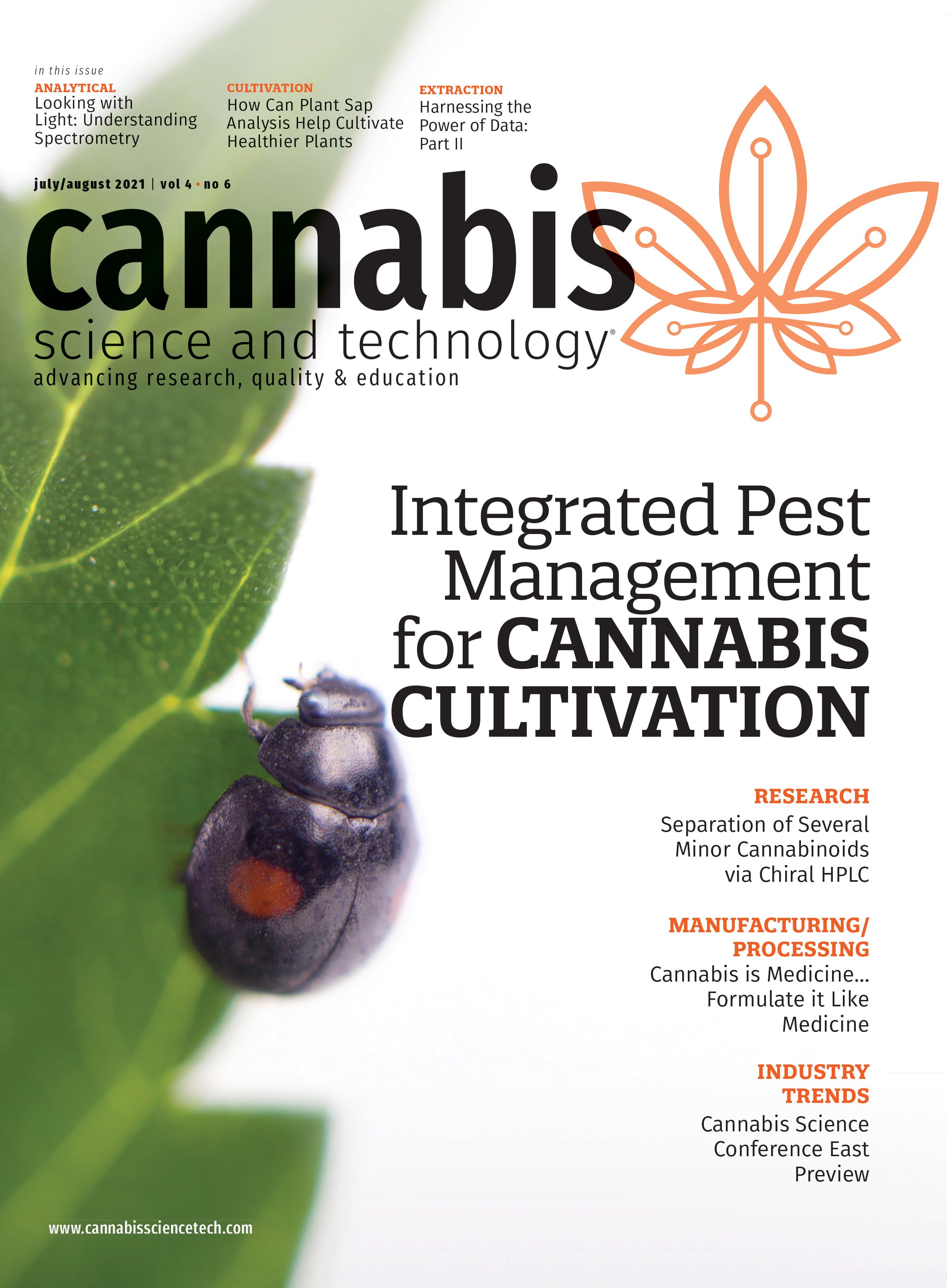
A Call for More Representative Horticultural Lighting Metrics for Cannabis Cultivation
March 5th 2025This article explores fundamental principles of photobiology, including Photosynthetically Active Radiation, photoreceptor-mediated responses, and the spectral influences on plant morphology and development.